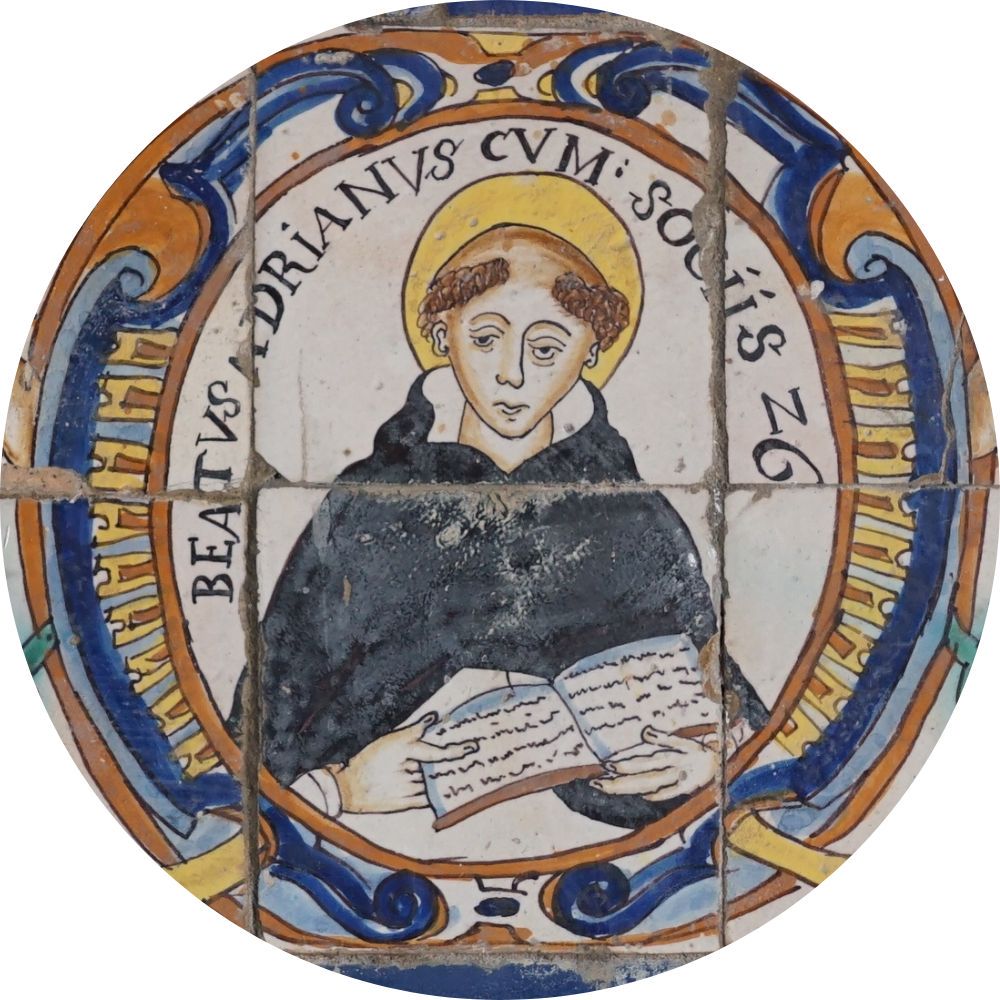Adrian and 26 companions
Adrian and 26 companions
(† 1233)
The representation clearly suggests that it is about Bl. Adrian and 26 companions. Only one person with this name appears among Dominican saints and blessed figures. He is the Dominican of the Third Order, Bl. Adrian (Hadrian) Fortescue (1476-1539), both husband and father of the family. He came from Devonshire, England, and was a justice of the peace in Oxford County. He also belonged to the Third Order of St. Dominic. After the king broke with Rome, many Catholics faced repression, and it affected him as well, although he tried as much as he could to be faithful to the king, but also to the Catholic Church. After his first arrest in 1534, no charges were filed against him or the reasons for his release. He was imprisoned a second time five years later, and a death sentence was imposed then. He was beheaded on July 8 or 9, 1539. His cult was approved by Pope Leo XIII on May 13, 1895.
However, it should be noted that this martyr is represented alone, without his companions. Meanwhile, the medallion clearly indicated how many there were. It seems, therefore, that the author (or authors) of the decoration did not mean the English Dominican Tertiary.
Due to the fact that we are dealing not only with Adrian himself, but also with 26 companions, it can be assumed that this is about martyrs. Following this trail, it was possible to find only Adrian, the Prior of Halych, who appears with just such a number of companions, his confreres. I found information about these Dominican martyrs in an 18th-century print titled Dni Roczne Swiętych, Błogosławionych, Wielebnych y Pobożnych Sług Boskich Zakonu Kaznodzieyskiego, S. Oyca Dominika (Krakow 1743) by the Polish Dominican, Michał Siejkowski (1695-1752). The first part of the book is a Dominican calendar of saints, blesseds, martyrs and saints of the Order of Preachers, which were popular in the 16th-18th centuries around the world. On May 6, it stated: "On this day the Commemoration of the Martyrdom of the Holy X. Adrian, Prior of Halych, Doctor of Theology, and 26 Brothers Poles, who at the telling of the Holy Faith were captured from the Pagans and driven on sharp piles." A little more information about them is provided by the Polish Dominican historian, Abraham Bzowski (1567-1637), in his work entitled Propago Divini Hyacinthi Taumaturgi Poloni, published in Venice in 1606. On page 20 he states: „B. Adrianus magister cum sex et viginti fratribus, ab eisdem hostibus Christiani nominis, palis in fixi praecitis, martyrio coronati sunt”. Their martyrdom at the hands of the Tartars was said to have occurred in 1233, which was still during the reign of St. Peter. The order was founded by St. Hyacinth of Poland, the founder of the order in Poland.
It should also be mentioned that in a similar period to Bzowski, a work on Dominican saints was also written by a Bolognese Dominican, Michele Pio. It turns out that he places Adrian and his companions not in Rus, but in Dalmatia, emphasizing that they suffered martyrdom at the hands of Muslims. Stephanus de Sampayo reports something even different. He writes that Br. Adrian (also called Alberte) was Prior in Hungary and died at the hands of the Turks in 1240 along with twenty-five of his brothers.
It is difficult to confirm whether the martyrs described by these Dominican authors even existed. Contemporary Polish historiography casts doubt on much of the information given by Bzowski, due to the lack of any corroboration in earlier sources, not only from the time of their martyrdom, but also later ones that would speak of the existence of a monastic tradition. Undoubtedly, in the 17th century, Bzowski's works, especially his Annales ecclesiastici (a work started by Cardinal Caesar Baronio and continued by a Polish monk after his death in 1607) and Prapago Divini Hyacinthi, was well-known not only in Poland, but throughout Europe, especially in Dominican circles. It is these two works that Dominican historiographer Vincent Maria Fontana (d. 1610/11-1679) cites in his Monumenta Dominica. He too, following Bzowski, mentions the martyr Adrian (here Hadrian) and his companions. It can be assumed that both Bzowski's works and, even more, Fontana's, were also known on both American continents and in the Far East, where missionaries brought them. If, in fact, we consider that this medallion from Lima's Santo Domingo Monastery depicts a 13th-century Dominican prior and martyr in Halych, this is the second medallion depicting Polish Dominicans.
Bibliography:
- Sampayo S. de, Thesaurus arcanus. Lusitanis gemmis refulgens, in quo Ægidii Magi olim theurgici stupe[n]da historia, variis exculta dialogis, atq[ue] alioru[m] S. Patru[m] Ord. Præd. ex eade[m] Lusitania, gesta, multaq[ue] alia scitu dignissima contine[n]tur, qu[a]e versa pag. indicabit, Paris 1586, k. 247v.
- Bzovius [Bzowski] A., Propago D[ivini] Hyacinthi Thaumaturgi Poloni, seu De rebus praeclare gestis in Provincia Poloniae Ordinis Praedicatorum, Venetii 1606, p. 20.
- Piò Michele, Delle vite de gli huomini illustri di S. Domenico, cz. 1: Que comendiosamente si tratta de i Santi, Beati, e Beate, Potifici, Cardinali, Patriarchi, e Vicecancellieri dell’Ordine di S. Domenico, Bologna 1607, kol. 342.
- Fontana V. M., Monumenta Dominica breviter in synopsim collecta, de fides obsequiis ab Ordine Praedicatorum Sanctae Dei Ecclesiae usquemodo praestiis, Romae 1675, p. 31.
- Siejkowski M., Dni roczne Dni Roczne Swiętych, Błogosławionych, Wielebnych y Pobożnych Sług Boskich Zakonu Kaznodzieyskiego, S. Oyca Dominika, Kraków 1743, k. B.
- Camm B., Lives of the English Martyrs, vol. 1, London 1904, pp. 412-461.
- Holy Dominicans. Biographical Summaries & Feast Days of Dominican Saints and Blesseds with Selected Patrons and Commemorations, New York 1997, p. 27.

